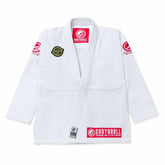Best Martial Arts for Skinny or Small-Bodied People: Why BJJ Leads the Way
When people think of martial arts, they often imagine muscular fighters or heavyweight champions. But the truth is, martial arts is not just about brute strength. For skinny or small-bodied individuals, many disciplines offer unique advantages. Particularly those disciplines that emphasize technique, leverage and intelligence over size or power. Among these, Brazilian Jiu Jitsu (BJJ) stands out as one of the best martial arts for smaller individuals to excel in.
It does not matter if you are naturally lean, short or just do not have a bulky frame. There is a martial art out there that can transform your physique, boost your confidence and equip you with effective self-defense skills. Let’s explore the top martial arts suited for small-bodied practitioners—with a special spotlight on BJJ, the “gentle art.”
Why Body Size Matters in Martial Arts
Body size plays a role in how one applies and adapts martial techniques. Heavier and stronger practitioners often rely on power. But smaller fighters must master precision, timing, flexibility and leverage. This is why certain martial arts are more compatible with a lean build—because they neutralize strength with strategy.
1- Brazilian Jiu Jitsu (BJJ) – The #1 Choice for Small Fighters
If you are small-bodied and looking for the most effective martial art for self-defense, competition or fitness, Brazilian Jiu Jitsu should be at the top of your list.
What Makes BJJ Ideal for Small Practitioners?
- Technique over strength: BJJ is all about using leverage, body mechanics and position to overcome size and power disparities.
- Ground fighting advantage: Fights often end up on the ground, where strength is less decisive. In BJJ, you will learn to dominate from the bottom position.
- Submissions and control: Techniques like chokes, joint locks and sweeps allow smaller practitioners to subdue larger opponents effectively.
Real-Life Examples
Many world-class BJJ athletes—like Mikey Musumeci and the Mendes brothers—have smaller frames. But consistently outperform bigger competitors thanks to technique, speed and timing.
Gi vs No-Gi for Small Fighters
- Gi training emphasizes grip fighting, control and precision. The BJJ Gi allows for more defensive strategies. Thus, favoring small-bodied athletes who play the long game.
- No-Gi tends to be faster and more explosive. But it still allows small fighters to shine through positional excellence and scrambles.
It does not matter if you are wearing a BJJ Gi or rash guard. Brazilian Jiu Jitsu creates a level playing field that empowers the small to overcome the strong.
Guide > Top 10 Reasons Why Brazilian Jiu Jitsu is the Best Martial Art
2- Judo – Throwing Giants with Leverage
Judo focuses on throwing techniques and takedowns using an opponent’s force against them. Like BJJ, it rewards timing and technique over raw strength.
Advantages for Smaller Fighters:
- Uses momentum and angles to off-balance opponents.
- Allows small practitioners to throw much larger opponents with proper technique.
- Teaches strong grip control through the Gi, which translates well to BJJ.
However, Judo can be physically demanding on the joints, especially for smaller practitioners going against much heavier opponents. Still, many lightweight Judokas have achieved success on the world stage.
3- Wing Chun – Close-Range Speed and Precision
This traditional Chinese martial art is designed for fast, close-range combat. Thus, making it ideal for small-bodied practitioners.
Key Benefits:
- Emphasizes speed, structure and redirection over power.
- Teaches sensitivity through “Chi Sao” (sticky hands), which helps develop reflexes.
- Developed for real-world self-defense, especially in tight spaces.
While not as competition-oriented as BJJ or Judo, Wing Chun is practical for quick defensive reactions and controlling aggression with calmness and precision.
Guide > Is BJJ Effective in a Street Fight?
4- Boxing – Footwork and Speed Over Power
Boxing may seem like a power sport. However, lightweight and featherweight boxers dominate with technique, footwork and speed.
Pros for Small Fighters:
- Develops timing, distance control and movement.
- Teaches how to generate power through body mechanics rather than brute strength.
- Encourages cardio fitness and sharp reflexes.
Boxing is a striking art and does not teach grappling. Thus, combining it with Brazilian Jiu Jitsu creates a complete and balanced skillset.
5- Taekwondo – Agility and Speed for the Win
Taekwondo is known for its fast, high kicks and acrobatic movement. Taekwondo suits lighter frames that can move quickly and execute rapid combinations.
Ideal for:
- Developing flexibility and explosive kicking power.
- Competing in weight-class tournaments.
- Improving leg dexterity, balance and coordination.
While not the most effective for ground defense, Taekwondo is a solid striking art. It builds confidence and athleticism in smaller fighters.
6- Muay Thai – The Art of Eight Limbs
Though Muay Thai can seem brutal, it offers smaller fighters a way to win using clinching techniques, elbows and knees, not just punches or kicks.
Why It Works:
- Focus on close-range striking.
- Develops mental toughness and conditioning.
- Teaches how to close the distance and neutralize reach advantages.
Muay Thai also complements BJJ perfectly, giving a smaller practitioner both standing and ground-fighting capabilities.
The Power of Combining Arts: BJJ + Striking
For small-bodied individuals, BJJ combined with a striking art (like Boxing or Muay Thai) creates an extremely effective self-defense system. On the ground, BJJ gives the upper hand. On the feet, striking keeps you safe until the fight can be taken to your area of strength.
What to Look for in a Martial Art School
- No matter the art you choose, make sure your training environment:
- Encourages technical development over ego.
- Offers classes for all sizes and experience levels.
- Has a culture of mutual respect and safety.
When selecting a BJJ academy, check whether they offer Gi and No-Gi training, regular sparring and experienced coaches who understand how to develop smaller athletes.
Final Thoughts: Why BJJ is the Best Starting Point
For skinny or small-bodied people, Brazilian Jiu Jitsu is more than just another martial art. It is a pathway to empowerment. With its focus on technique, leverage and control, BJJ proves that size does not define success.
In a world where bigger often means better, BJJ flips the narrative. It shows that with the right mindset, training and support, even the smallest person can control, dominate and submit a much larger opponent.
So does not matter whether you are putting on your first BJJ Gi or stepping into a new martial art gym. Remember this: greatness is not measured by your size—it is measured by your heart, your discipline and your technique.







